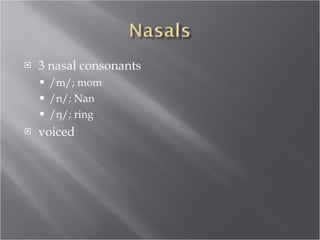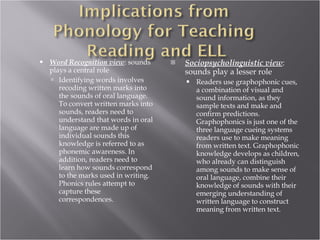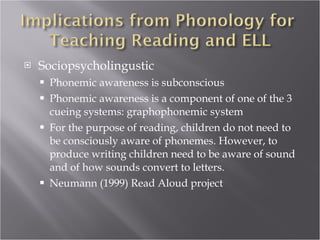Session 3 english phonology
- 1. ╠²
- 2. How do people understand and produce language? What is phonology and what are the phonemes of English?
- 3. ╠²
- 4. Express and receive ideas Sound travels Sound is functional in the dark
- 5. The brain sends messages (signals) to tighten and relax the muscles that control speech (lungs, vocal cords, tongue, lips)
- 6. Phonology-the study of speech sounds Phonemes-meaningful sounds of language Linguistic-scientific study of language Phonetics-study of sounds across languages
- 7. ╠²
- 8. Air not constricted in pharynx; air flows freely for all vowel sounds Movement of the tongue and lips change the shape of the oral cavity to produce different vowel sounds Linguist may refer to vowels as syllabics-each syllable contains vowels
- 9. English consist of short (lax), long (tense), reduced vowels All vowels are voiced 6 short vowels 7 long vowels (called diphthongs-2 sounds) 2 reduced vowels Other factors effecting vowels
- 10. Say the following words paying attention the position of the tongue. Pit, pet, pat, putt, put, pot What did you notice? Now say the words again using the mirror to see the position of the tongue. What did you notice?
- 11. Air is constricted as it moves towards the lips (slowing down or stopping) Different consonant sounds depend on how and where air is slowed or stopped (voiced, voiceless) Air maybe constricted at lips, teeth, alveolar ridge, hard palate, soft palate or velum Generally appear in matched pairs one voiced and the other voiceless 24 consonant phonemes
- 12. Bilabial Labio-dental Inter-dental Alveolar Alveo-palatal Velar Glottal Stops Voiceless Voiced p b t d k g fricatives Voiceless Voiced f v ╬Ė ├░ s z ┼Ā ┼Š h affricates Voiceless Voiced ─Ź čś╠å nasals Voiced m n ┼ŗ liquids Voiced r, l glides Voiced y w
- 13. Formed by completely blocking the air for an instant and then releasing it 3 pairs of stops /p/,/b/ (bilabial) /t/, /d/ /k/, /g/ 3 pairs of stops set apart in the vocal tract (front of mouth, middle of mouth, and back of mouth)
- 14. Constricting airflow through the vocal tract which causes friction; friction sets air molecules in motion as they pass through the narrow opening; this action produces sound 9 fricatives; in pairs except /h/
- 15. Briefly stopping air flow then releasing it with some friction Combination of a stop and a fricative 2 affricates in English language /─Ź/, / čś╠å /
- 16. 3 nasal consonants /m/; mom /n/; Nan /┼ŗ/; ring voiced
- 17. Smooth sound 2 phonemes called liquids /l/, lull /r/, roar
- 18. 2 consonant phonemes Sometimes called semivowels /y/, yes /w/, wet Only occur at the beginning of a syllable in English or as part of a blend (swing)
- 19. Try to say ŌĆ£Peggy BabcockŌĆØ 5 times as fast as you can. What did you notice? What did you notice when you said the name the second time? Why might this occur?
- 20. Word Recognition view : sounds plays a central role Identifying words involves recoding written marks into the sounds of oral language. To convert written marks into sounds, readers need to understand that words in oral language are made up of individual sounds this knowledge is referred to as phonemic awareness. In addition, readers need to learn how sounds correspond to the marks used in writing. Phonics rules attempt to capture these correspondences. Sociopsycholinguistic view : sounds play a lesser role Readers use graphophonic cues, a combination of visual and sound information, as they sample texts and make and confirm predictions. Graphophonics is just one of the three language cueing systems readers use to make meaning from written text. Graphophonic knowledge develops as children, who already can distinguish among sounds to make sense of oral language, combine their knowledge of sounds with their emerging understanding of written language to construct meaning from written text.
- 21. Phonemic Awareness: A Key to Word Recognition Stanovich (1986) ŌĆ£ Matthew Effect in ReadingŌĆØ Identified phonemic awareness as the key factor that differentiated good readers from poor readers Phonemic awareness appears to help children learn to read and reading helps build phonemic awareness
- 22. Adams (1990) identified 5 levels of phonemic awareness: rhymes and alliterations in nursery rhymes Do oddity task (picking out a word that starts with a different phoneme from others in a series) Blend or split syllables Perform phonemic segmentation (count the number of phonemes in a word like cat) Perform phoneme manipulation task (adding, deleting, substituting phonemes) Items 1 and 3 appear to be phonological because they involve working with units bigger than phonemes
- 23. The National Reading Panel Report (2000) Phonemic awareness and phonics important Put Reading First (Armbruster and Osborn, 2001) Phonemic awareness can be taught and learned Phoneme isolation (What is the first sound in van?) Phoneme identify (What sound is the same in fix, fall, fun?) Phonemic categorization (Which word doesnŌĆÖt belong-bus, burn, rag?) Phoneme blending (Combine individual phonemes to for words) Phoneme segmentation (Divide a word into its phonemes and say each one)
- 24. Put Reading First: ŌĆ£ phonemic awareness instruction is most effective when children are taught to manipulate phonemes by using the letters of the alphabet.ŌĆØ (p.7) Logical teaching sequence: Phonemic awareness skills Names and sounds of letters Phonics rules Sight words Structural analysis skill
- 25. Sociopsycholingustic Phonemic awareness is subconscious Phonemic awareness is a component of one of the 3 cueing systems: graphophonemic system For the purpose of reading, children do not need to be consciously aware of phonemes. However, to produce writing children need to be aware of sound and of how sounds convert to letters. Neumann (1999) Read Aloud project
- 26. After the discussion today: What do you see as possibilities?
Editor's Notes
- #4: Make a list of different facts about communication that this model fails to capture. Sketch out a model that would include some of these missing features. Missing facts speaker/listener share knowledge of reference; listener decides is an utterance is literal or nonliteral, direct or indirect. Read aloud an Amelia Bedelia book.
- #6: During normal conversation, humans produce an average of eight phonemes (distinctive, meaningful sounds) per second. Able to maintain this rate of production over a long period of time without fatigue. The messages the brain sends out are so complicated that they must be acquired. ŌĆ£These features of speech are complex and automatic physical gestures which cannot be learned, but are among the biologically innate features that facilitate the acquisition of speech by the human species.ŌĆØ
- #8: Speech sounds are formed by changes in the vocal tract-area between vocal cords (elastic bands of tissue located in the larynx) and lips. When the vocal cords are brought close together air passing through caused vibration (voicing); when held apart no vibration (voiceless).
- #10: Terms reflect the relative tension of the muscles as the sounds are produced;
- #11: Native speakers of English have difficulty in feeling these variations in tongue position; produce these sounds effertlessly without awareness of tongue position; ELL often have difficulty distinguishing between words that differ by just one of these vowel sounds. However during normal converstaion they can use other clues to determine the meaning.
- #12: Nonsyllabic because consonants by themselves do not constitute a syllable. Syllables consist of a series of alternating vowel and consonant sounds. There is a limit on the number of consonant sounds that can be produced in sequence because consonants involve blocking the air in different ways.
- #14: Bilabials some of the first sounds babies produce (papa, mama-formed with low back vowel /a/ which is one of the first vowels children produce); formed by stopping the air by closing the lips ex. Sounds at the beginning of pop & bib. /t/, /d/ phonemes present at the beginning and end of words like tot & dad; sound produced by placing the tip of the tongue behind the front teeth along the alveolar ridge to block the air from a moment. /k/, /g/ formed by raising the blade of the tongue up against the velar rigion in the back of the mouth to temporarily block the air. Occurs at the beginning and end of words like kick and gig.
- #15: /f/, /v/ biting down on the lower lip; produces sound heard at the be ginning and end of fluff and verve. The interdental fricatives made by putting the tongue between the teeth and forcing air through the opening; name comes from Greek words theta and eth. Examples thigh, thin, bath / ╬Ė / and thy, then, bathe /├░/. With can be prduced using either sound. /s/, /z/ produced by putting the tip of the tongue against the alveolar ridge but lowered enough to let some air go through; sip, zip kiss, fuzz. Cover ears to hear the difference in voiced/voiceless sound. /┼Ī/, /┼Š/ sound produced by flattening the tongue along the roof of mouth, the alveopalatal area. /┼Ī/ ship, dish; /┼Š/ less common never starts a word except for a borrowed word or name Zsa Zsa most commonly in middle of words like confusion represented in spelling by si. /h/ special case; produced in different ways often made by slowing the air as it passes through the glottal area. Like in hop felt in throat causing some vibration before the onset of the vowel sound. voiceless
- #16: /─Ź/ is combination of /t/, /┼Ī/; heard at beginning and end of church; can be spelled tch as in watch / čś╠å / is combination of /d/, /┼Š/; occurs twice in judge; can be spelled dge as in badge
- #17: Produced by stopping the air in the oral cavity and lowering the velum so that the airflow can pass through the nasal cavity. /m/ blocking the air with the lips; /n/ stopping the air at the alveolar ridge; /┼ŗ/ blocking off the velar area
- #18: /l/-Tip of tongue placed against the alveolar ridge and lowers on side of the tongue to let the air pass through on that side; since air passes on one side referred to as lateral. /r/ produced by curling the tongue tip back slightly. Tongue does not touch another part of the mouth but the raising and curling the tongue changes the shape of the oral cavity. As the tongue unclurls, a vowel sound is produced but the actions of the tongue colors the vowel.
- #19: Produced by moving the tongue up toward the alveopalatal or velar region. In the case of the /w/ the lips are also rounded
- #20: Most people cannot do this because of the physical movement of the tongue (front to back) and the mixed patterns the brain has to deal with (sending messages to several areas of the mouth and vocal tract). Tongue goes front, back, front, front, back, back. Pattern of voicing: voiceless, voiced, voiced, voiceless, voiceless. Why

























